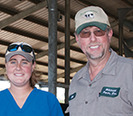
In September of 2021, calf No. 939 was born here on the farm. There was nothing that made her different than the rest of the heifers born at the time. About two weeks after birth, No. 939 became sick. She was scouring and looked pretty lethargic, but she had a good bit of fight in her.
We kept her hydrated and comfortable. Eventually we moved her into isolation so that none of the calves around her would get whatever she might have. I could tell whatever it was that was taking a toll on her was giving her a run for her money, but she wouldn’t give up.
We tend to move calves into isolation for a couple of days if they become sick, but it’s not just your average change in milk consumption looseness. She stayed there a bit longer than other calves that go into isolation for recovery. That meant she got more one-on-one time with our staff. Once she seemed to be over the hill with the sickness and feeling better, she wanted constant head scratches and chin scratches and would follow people around.
She was able to return to the rest of the calves, and in the months that followed, she became just about everyone’s favorite calf. Time passed on and eventually she was in our heifer breeding herd. She was a little bit smaller than the rest of her age group, so we had kept her back to grow with the age group behind her. Dad had said several times we might need to sell her because she might not ever catch up to be big enough for the milking herd. We kept telling him she would catch up while giving her more goods on the side than what the rations for the growing heifers were calling for.
Once she was in the heifer breeding herd, we waited and waited for her to come in to heat. We had the vet check her a few times, and she repeatedly had “static ovaries,” which pretty much means nothing was going on. I was worried after a few months that she would never show a heat, and then we would have to sell her.
By this time, not only the farm staff had gotten to know No. 939, but through social media, my friends outside of the farm knew exactly who she was as well because I would post videos and pictures of her. She was so lovable that if you sat down in the pasture, she would practically try to lay in your lap. Finally, I had enough people trying to name her, so we settled on Loretta.

Her pregnancy went well with no complications until it was time to move her into the “Moo-ternity” pen for the last three weeks of gestation. At the time, my dad was helping move heifers in and I was at the heifer farm so couldn’t help. He doesn’t do as much work with the cows anymore, so he had forgotten who Loretta was. Once they got her inside that barn, he tried everything he knew to do to get her to the pen, but she didn’t know him and decided she wasn’t moving.
Needless to say, by the time I got back to the main farm, he was fit to be tied. He walked past me and said, “Something is wrong with that heifer down there, I can’t get her to move.” I asked the number and when he said No. 939, I busted out laughing. He just stared at me, not laughing.
I said, “That’s Loretta! Did you talk nicely and scratch her head and put feed in your hand?” He still just stared angrily. I walked down there, did just that, and she followed me straight to the pen.
A few weeks later, it came time to have her calf. Our staff and friends had been patiently waiting for this day. We began to see feet and moved her to the bedded pack to calve. We watched for a bit, but since she was a smaller cow and the feet coming out were pretty big, we ended up assisting with the delivery. She had a healthy bull calf.

After calving, it was her time to enter the milking herd. This was the moment we had been worried about — robot training. She was probably the most “pet-like” cow we have ever had, so getting her to do something that is different or looks funny to her is usually a difficult task. However, we are currently on Day 2 of training, and Loretta has figured out that the pellets in the robot taste pretty good, so we haven’t had a lot of refusal from her. Time will tell, but her bloodlines are good, and she has the potential to be a really good milk cow.
We all know those “pet” cows can be a little aggravating, but sometimes it’s nice to walk into a herd of cows, holler out a name, and see the cow’s head pop up as she walks over for a scratch. It’s a good five-minute break from work, and let’s be real — who wouldn’t love some attention from a cow?

Mark and Caitlin Rodgers are dairy farmers in Dearing, Georgia. The Rodgers have a 400-cow dairy that averages 32,000 pounds of milk. Follow their family farm on Facebook at Hillcrest Farms Inc.








